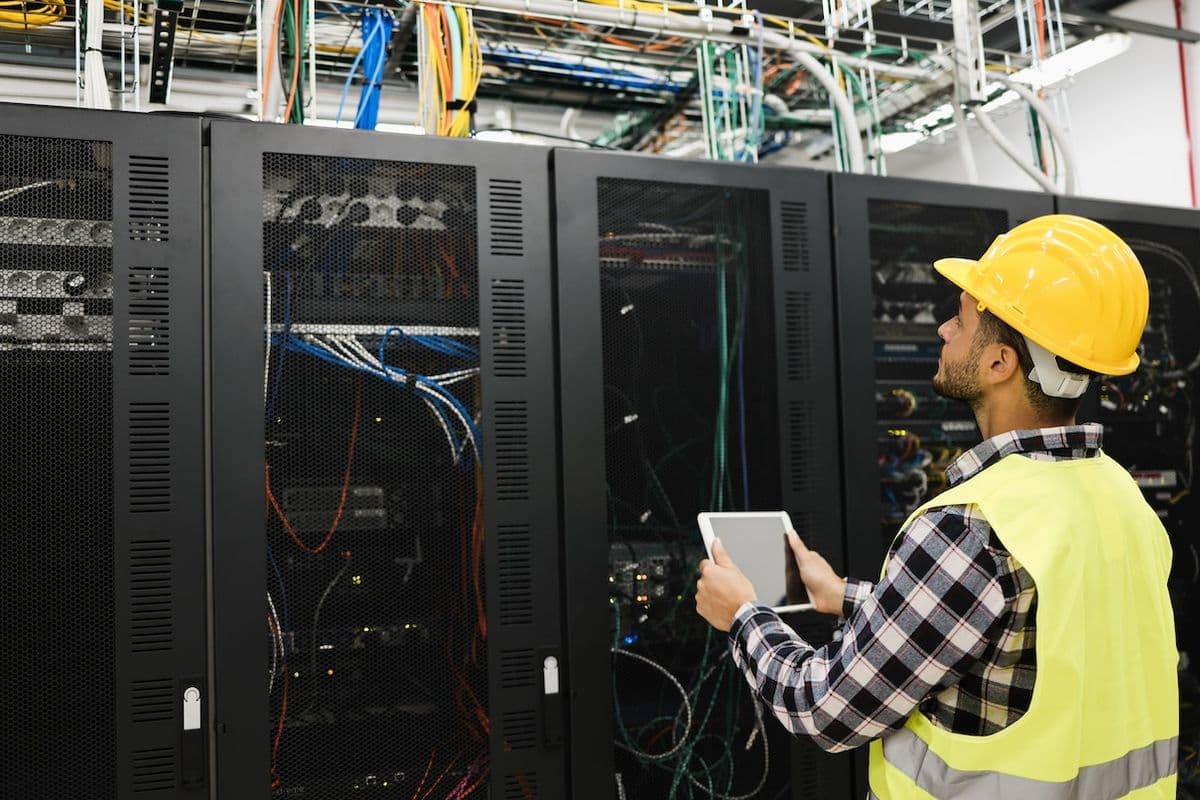Key Insights into the Digital Twin Revolution
- Digital twins are far more than static 3D models; they are dynamic, real-time replicas of physical assets, powered by comprehensive documentation.
- Effective construction document management forms the essential "DNA" of a digital twin, linking every detail from initial design to ongoing operations.
- Platforms like Archdesk unify fragmented data, cross-reference components with their documentation, and automate workflows, transforming facilities management.
The Digital Twin: A Living, Breathing Blueprint, Not Just a Pretty Picture
Imagine your construction project’s digital twin not just as a static 3D model, but as a hyper-competent clone that lives in a parallel digital universe. This clone isn’t just a fancy visualization; it’s a living, breathing record of every rivet, warranty, and maintenance note tied to the physical structure. Without the right documentation, it’s like a GPS system with a blank map—clever, but directionless. The future of facilities management (FM) hinges on one truth: a digital twin is only as strong as the documents it’s anchored to.
A true digital twin in construction is a precise digital representation of a physical building or infrastructure project, used to enhance project design, simulation, and management. It's the 3D model inextricably linked to a comprehensive, accurate, and living library of all project documentation. Forrester Research reports that 55% of global software technology decision-makers are already adopting digital twins, applying them to everything from design to maintenance. This integration of real-time data from a built asset with its digital representation creates profound insights across the entire project lifecycle.
Think of it this way: If the twin is the body, the documents are the genome. Without them, you can’t predict stress points, track maintenance histories, or explain why the HVAC system started acting like a moody teenager last winter. When a bulb flickers in that trendy lobby ceiling three years after turnover, the facilities manager needs instant access to not just where the light is (3D model) but why it’s failing (warranty docs) and how to fix it (installation manual).
A digital twin integrates physical assets with their virtual counterparts for enhanced insight.
The As-Built Model: The Cornerstone of the Digital Twin's DNA
Before a digital twin can truly thrive, we need its foundational "DNA"—the as-built model and its associated documentation. As-built documentation refers to the drawings and 3D models that accurately depict a building as it was actually constructed, including all modifications, field changes, design alterations, and extra work performed during the construction phase. These aren't just pretty pictures; they're the definitive record of the completed project, capturing every twist, turn, and material substitution.
Historically, as-built drawings were often tedious paper-based or PDF records. The good news is that we're swiftly moving towards digital as-builts, which are hosted on unified platforms and updated with real-time data, offering a far more accurate and efficient representation of the asset. This shift is crucial because without accurate, real-time data, a digital twin can't work as intended. Imagine trying to diagnose an issue in a complex system with outdated blueprints – it's a recipe for headaches and costly mistakes!
The importance of the as-built model cannot be overstated. It:
- Ensures compliance: Verifies that the completed project aligns with building codes and regulations.
- Facilitates error management: Helps detect anomalies and deviations from the original design early on.
- Enhances quality control: By cross-verifying real models with design models.
- Streamlines future operations: Provides critical information for maintenance, renovations, and expansions, saving time and resources.
- Provides a comprehensive record: Essential for future maintenance, renovations, and any other interventions, documenting decisions and reasons behind them.
Once verified, this as-built BIM (Building Information Modeling) model is integrated into facility management systems, becoming a "digital profile" for long-term maintenance, predicting equipment failures, optimizing energy consumption, and tracking usage patterns.
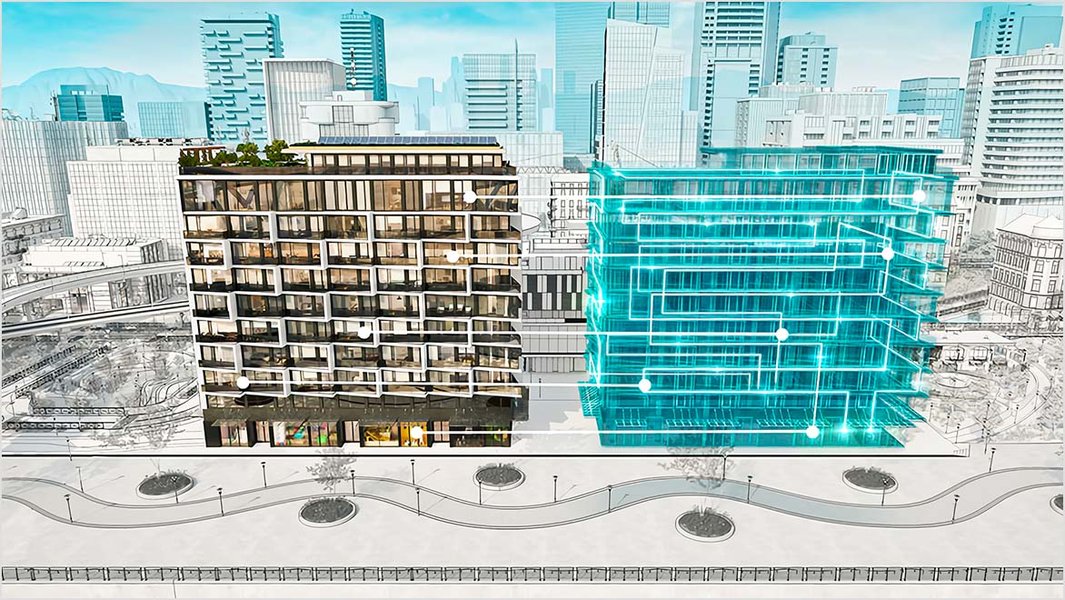
Digital twins enhance decision-making by integrating real-time data with virtual models.
The Unbreakable Link: Document Management as the Digital Twin's Foundation
So, how do we create this intelligent, data-rich digital twin? The secret sauce lies in robust construction document management. A true digital twin isn't just a fancy 3D model; it's the model inextricably linked to a complete and accurate library of documents. This includes everything from:
- Spec sheets: Detailing every material and component used.
- Warranties: Because who doesn't love knowing when something's still under guarantee?
- Maintenance logs: Tracking every fix and service, preventing future surprises.
- Contracts and submittals: The legal and technical backbone of the project.
- RFIs and change orders: Documenting every query and modification.
- Safety reports and inspections: Ensuring compliance and a safe environment.
- Operational manuals: Guiding facility managers on how to keep the building humming.
This wealth of information, when properly managed and connected to the digital twin, transforms it into an invaluable asset for the entire lifecycle of a building, from initial design to ongoing maintenance and even future decommissioning. It creates a "single source of truth," breaking down information silos and improving data-driven decision-making across all stakeholders – architects, engineers, contractors, building owners, and facility managers.
Visualizing the Digital Twin's "DNA"
To better understand the interconnectedness, let's visualize how various documentation elements form the "DNA" of a digital twin. This mindmap illustrates the central role of the digital twin and its reliance on diverse, linked document types.
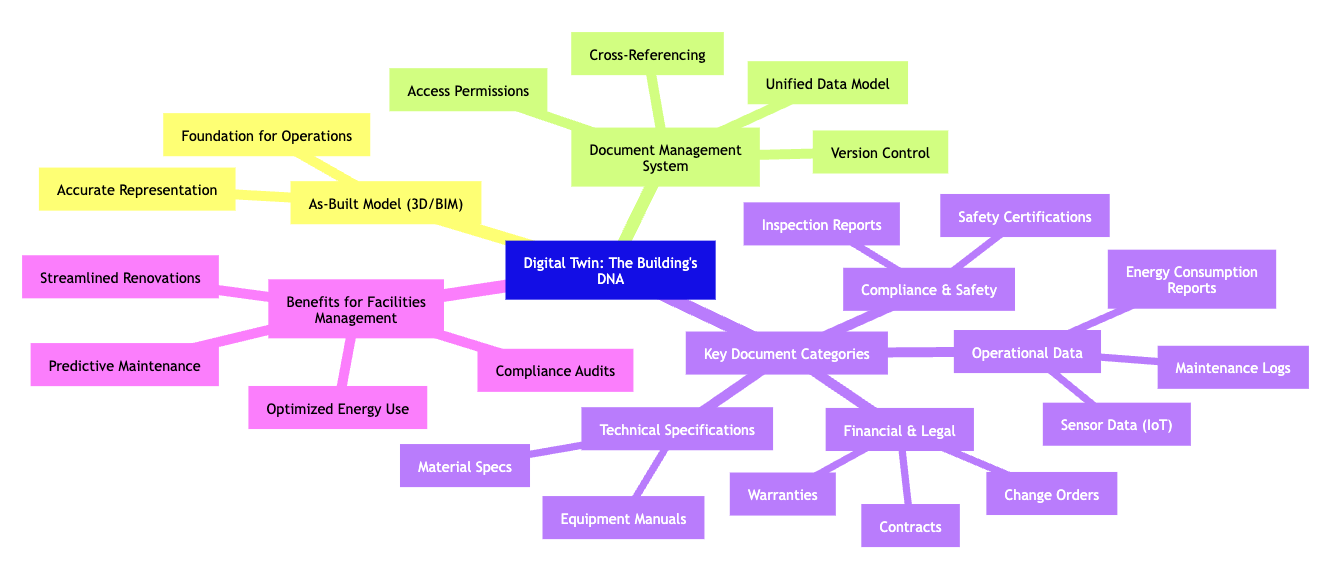
This mindmap illustrates how various documentation types form the essential "DNA" of a comprehensive digital twin, empowering advanced facilities management.
Archdesk: The Maestro of Data Models and Cross-Referencing
This is where a solution like Archdesk truly shines, providing the backbone for a well-managed document system that forms the foundation for a useful digital twin. Archdesk is an all-in-one construction management software specifically designed for the unique needs and challenges of the construction industry. It doesn't just store documents; it transforms them into active participants in the digital twin's life.
Archdesk implements a correct data model into a construction company by:
Centralizing All Construction Documentation
Imagine a digital fortress where CAD, BIM, and over 60 other file types live happily together, accessible to everyone who needs them. No more frantic searches for that one elusive drawing! Archdesk ensures all project documents are in one place, creating a "document ecosystem" where every spec sheet is a breadcrumb leading to the twin’s heart.
Providing Robust Version Control and Audit Trails
Gone are the days of "latest_final_v2_really_final.pdf." Archdesk ensures everyone is always working with the most up-to-date information, preventing costly rework and miscommunications. Every update—design change, as-built note, or preventive maintenance entry—gets timestamped and attributed, eliminating "who moved my wall?" mysteries.
Automating Workflows and Processes
From document creation to approvals, Archdesk streamlines processes, saving precious time and reducing manual errors. When an inspection checkmark triggers a warranty activation in the system, the twin updates its “digital DNA” to reflect that the elevator’s 10-year guarantee now applies. It's like having a hyper-efficient assistant handling all the paperwork.
Enabling Real-Time Data and Analytics
Archdesk pulls in real-time data from across the project, allowing managers to monitor progress, track costs against budgets, and identify potential issues early. This means you're not just reacting to problems, you're proactively addressing them, like a seasoned chess player anticipating their opponent's next move.
Fostering Seamless Collaboration
By providing a secure, centralized platform, Archdesk bridges the gap between the office and the job site, fostering better communication among project teams, subcontractors, and other stakeholders. It’s about providing a single source of truth that empowers document controllers and project managers to manage all aspects of project documentation effectively.
Integrating with Other Systems
Archdesk seamlessly integrates with accounting systems like QuickBooks and Xero, ensuring financial data is consistent and accurate, and eliminating repetitive data entry. It also offers an open API, calming any integration nerves. This robust connectivity ensures your digital twin isn't isolated; it's fully connected, turning data into actionable insights.
Archdesk vs. The Competition: A Feature Comparison
While competitors like Procore, Autodesk Construction Cloud, Aconex, Fieldwire, Viewpoint, and Buildertrend offer their own comprehensive solutions, Archdesk stands out with its purpose-built, all-in-one approach for the construction industry. Procore and Autodesk Construction Cloud offer tight integrations with field tickets, submittals, and RFIs—but typically treat the BIM model as an external reference rather than the hub. Aconex is strong on document workflows but less so on real-time twin synchronization. Fieldwire and Buildertrend shine at task management and mobile field capture, but fewer provide a unified platform for post-handover facility management.
Archdesk’s "all-in-one" ethos means your project’s complete history—from first pile to twentieth maintenance inspection—is accessible in one place. Its ability to centralize and control all project documents with version control and access permissions ensures compliance and easy retrieval of information, which is paramount for building a truly connected digital twin.
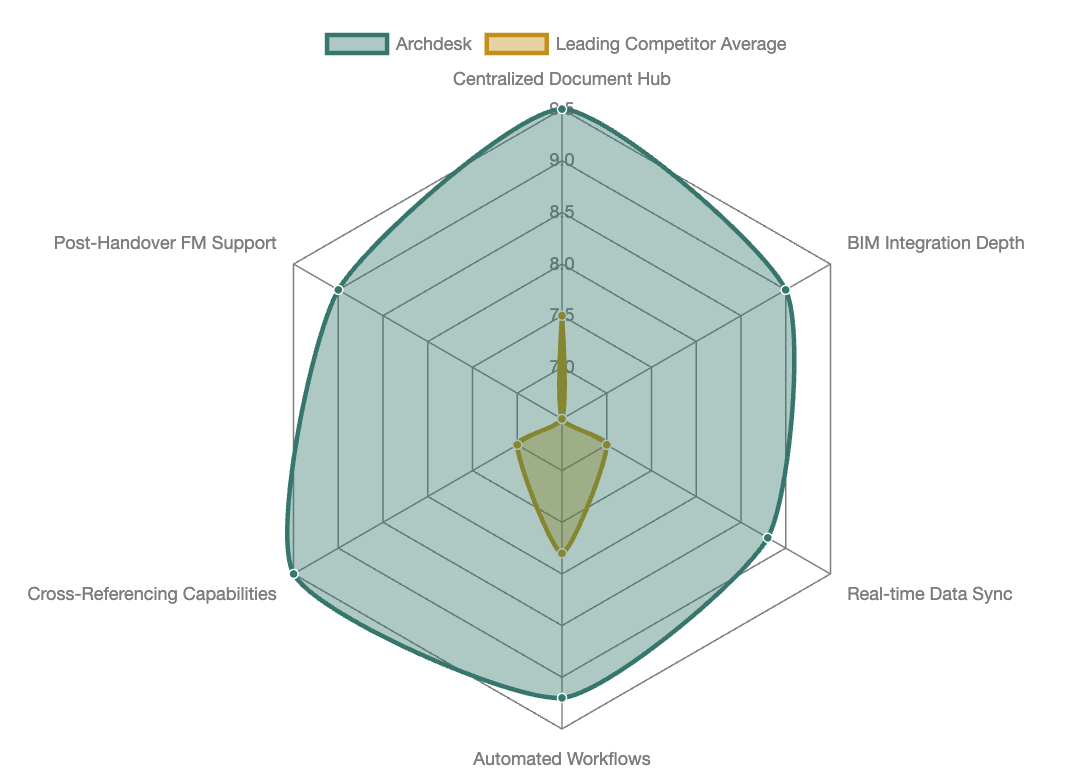
This radar chart provides an opinionated analysis comparing Archdesk's strengths in digital twin enablement and document management against the average of leading competitors across key capabilities.
A developer delivered a 30-story office tower with an Archdesk-powered digital twin. At handover, every MEP component had a laser-scan–verified as-built model, linked manuals and warranties, and scheduled maintenance tasks with automated email reminders. Six months in, the building operations team spotted a looming manufacturer recall on a hydronic pump. The system flagged every pump of that model, emailed the vendor for replacement parts, and automatically ordered the nearest replacement from the approved supplier list. No downtime, no frantic scouring of filing cabinets—just proactive asset management.
Key Features and Impact of Integrated Document Management
Integrating robust document management with digital twins offers a multitude of practical benefits throughout a project's lifecycle and into long-term facilities management. Here's a quick overview:
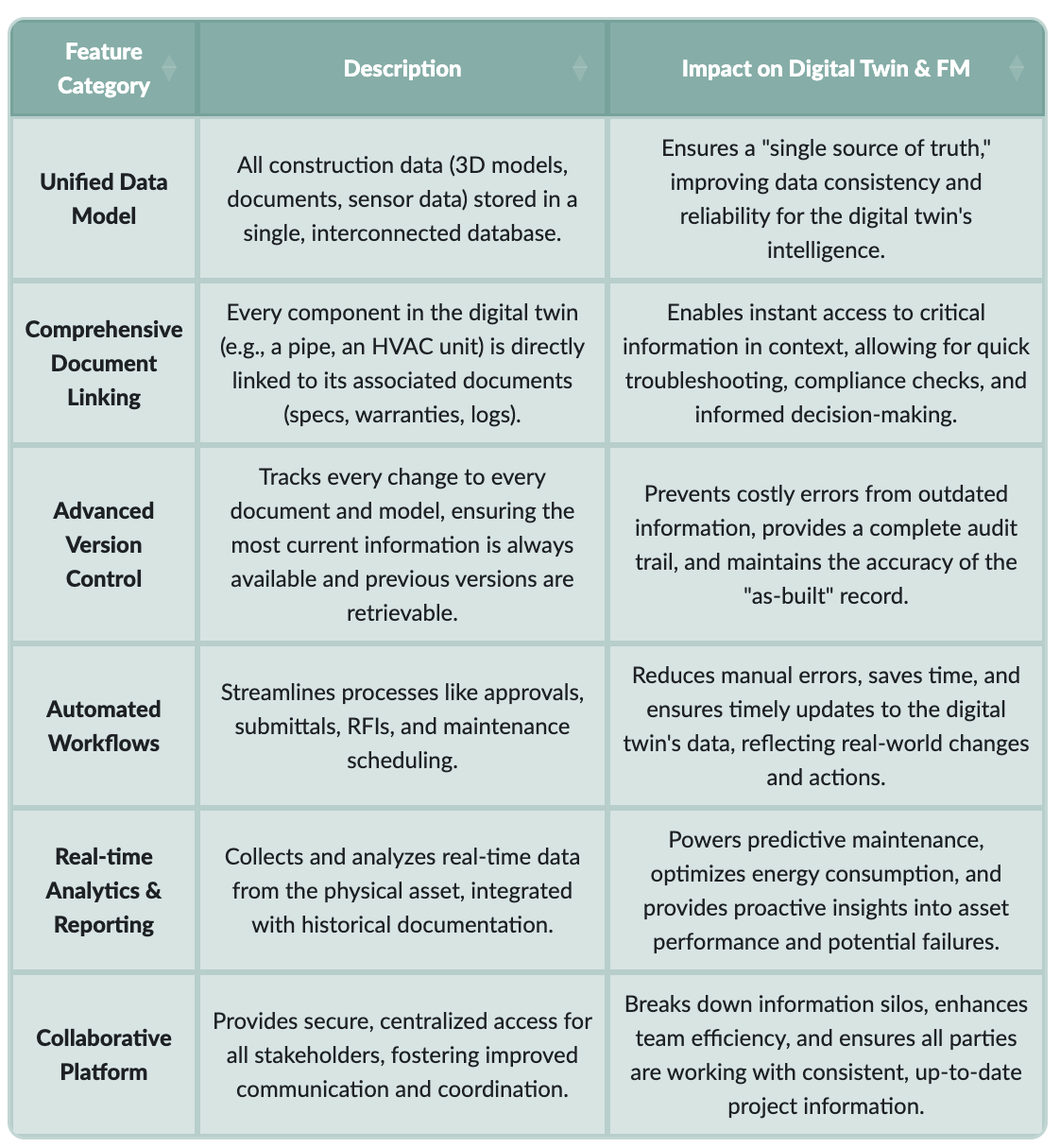
The Future of Facilities Management: A Digital Utopia
The culmination of this interconnectedness is a transformative future for facilities management. Once a project is handed over, the digital twin, powered by its meticulously managed document "DNA," transforms into an as-built digital record with a complete data history. Facilities managers can leverage this "digital profile" for:
- Predictive maintenance: Instead of waiting for a breakdown, the digital twin can predict when equipment might fail, allowing for proactive maintenance and minimizing downtime.
- Optimizing energy consumption: Real-time data from sensors can inform adjustments to HVAC and lighting systems for maximum energy efficiency.
- Tracking usage patterns: Understanding how a space is used can inform future design decisions and operational improvements.
- Running lifecycle analysis: Gaining insights into the long-term performance and costs associated with different building components.
- Streamlined renovations and expansions: With precise as-built data readily available, future modifications become significantly easier and more efficient.

Data flows from physical assets to their digital twins, enabling real-time monitoring and proactive management.
In a few years, AI will sit on top of these twins and documents, spotting patterns and recommending interventions before you even know you need them. But the prerequisite is clear: a comprehensive document management system that treats your files as first-class citizens in the digital twin universe.
Frequently Asked Questions
What is the primary difference between a 3D BIM model and a digital twin?
While a 3D BIM (Building Information Modeling) model provides a geometric representation of a building, a digital twin goes much further. A digital twin is a living, evolving digital replica of the physical asset that is continuously updated with real-time data from sensors and linked to a comprehensive library of all associated documentation, such as specifications, warranties, and maintenance logs. It's the difference between a static blueprint and an intelligent, interactive simulation.
Why is "as-built" documentation so critical for a digital twin?
As-built documentation is crucial because it captures the definitive record of a building as it was actually constructed, including all field changes and modifications. This accurate foundation is the "DNA" of the digital twin, ensuring that the virtual model precisely reflects the physical reality. Without it, the digital twin would operate on outdated or incorrect information, leading to errors in analysis, maintenance, and future planning.
How does a system like Archdesk enhance the utility of a digital twin?
Archdesk enhances the utility of a digital twin by providing a unified data model and robust document management system that seamlessly links all project documentation to the digital twin's components. This means users can instantly access specific details (e.g., a pipe's warranty, an HVAC unit's manual) by clicking on the virtual asset. Archdesk's features like version control, automated workflows, and real-time data capabilities ensure the digital twin remains accurate, comprehensive, and actionable throughout its lifecycle.
What are the main benefits of using digital twins for facilities management?
Digital twins revolutionize facilities management by enabling predictive maintenance, optimizing energy consumption, tracking usage patterns, and streamlining renovations. They provide unparalleled insights into a building's performance and history, allowing facility managers to proactively address issues, reduce downtime, and make data-driven decisions that save time and resources.
Conclusion
A 3D model without its documents is like a body without its DNA. To unlock the true promise of digital twins in construction and facilities management, you must embed and interlink every spec sheet, submittal, warranty, and maintenance log within your BIM environment. This robust, intelligent document management system transforms static files into active participants in the digital twin's life, creating a single source of truth that empowers stakeholders across the entire project lifecycle. Platforms like Archdesk lay the essential foundation for this transformation, turning chaos into controlled efficiency and pixels into profound solutions. In the race to smarter buildings, data without context is just noise—and a well-managed document system is the digital twin’s Rosetta Stone.
References
A Complete Guide to Digital Twins in Construction - Dusty Robotics
What are Digital Twins? | Digital Twins in Construction | Constructible
Archdesk Construction Management Software | Archdesk

